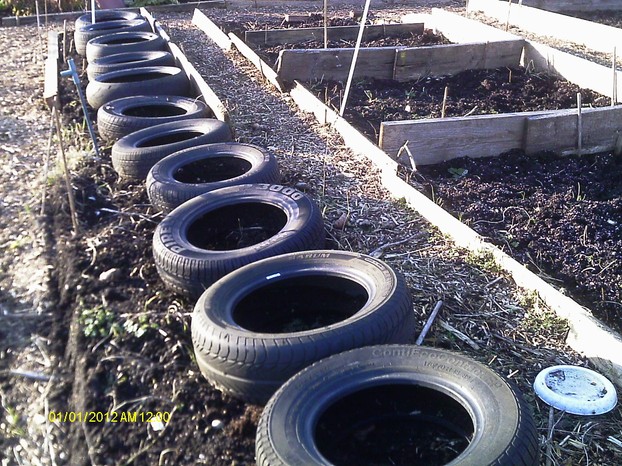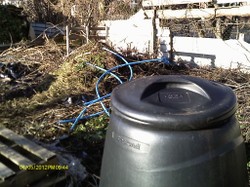There are changes in the garden every year, some of them to make improvements and others in response to problems. But there is probably a need for gardens to be relaid once every few years. I am in the midst of such a change, forced on me by the climatic conditions, but also by the need to make changes to an old layout. The main problem lies in the paths, which need to be relaid. But there are changes to be made in the way that I grow in the greenhouse, and a few more changes to other areas.

Revamping the Allotment
by frankbeswick
No garden design is for ever, and this year I am having to make some changes to the garden layout.
In Britain we have had a bad summer, the rain has been frequent, the sky has often been overcast, and potato blight has killed off the plants of several expert gardeners. It even hit the Royal Horticultural Society's partner garden in Devon, and if it hits experts like them, there is little hope for the rest of us. I was hit by blight, but not very badly, but my paths are simply in a state of decay, so a re-laying is needed.
I had better explain the history of it all. When I took over the plot in the 1990s I ran it in an unstructured way, but in 2005 I decided that a garden was better if structured, so I set about creating the lay out of beds and paths that you have seen in my pictures over the years. The paths were made of wood chip delivered free of charge by the council in the Fall [Autumn] as their tree surgeons were shredding unwanted trees and recycling the waste through allotments. It was an inspired decision, as the structure allowed me to organize my gardening and it survived for eleven years. Yes, I had to relay a new layer of wood chippings on an annual basis, as the previous year's offering decayed into soil, but nourishing soil that could send nutrients to plant roots in the beds, but the system worked-until now.
What has happened is that the decayed wood chip underneath the new surface has always had some couch grass roots in it, but I have been able to keep it down with weedkiller and strimming, but then a three fold problem occurred. First, the root build up reached a critical level; secondly the wet summer caused the weeds to grow in abundance;thirdly, as you may know from the comments columns on Wizzley, I have been having trouble with my left hand, so I have not been using the strimmer [cultivator.] The problem is osteo-arthritis, only the beginning, but it has impeded my work. Without the use of the strimmer, the grass has got out of control. I have been snipping it with edging shears, but that is a slow process and I have been finding that I am spending a disproportionate amount of time on my paths. Something needed to be done.
Now, my dream pathway is made of a thick layer of good Welsh slate fragments. Decay! That stuff has remained unchanged for hundreds of millions of years, but getting enough for an allotment's paths would cost a significant amount of money. So I am going for the next best thing: woven weed control fabric. Being woven it lets in water, but shuts out light. So the weeds die of lack of light, but the water does not pool up on the surface, and that is an important factor in an age and a place where flooding is becoming a problem. I am one of the lucky ones, for my site has not flooded,but on one of my society's eight sites three plot-holders have had their allotment under water for a year! The shape of things to come, I fear.
So I am covering the paths with woven fabric. The picture below shows the bed in which I grow herbs, each in its own planter. A layer of fabric is going to stretch across the paths on each side. I have been lifting the tyre planters and the will relay them on top of the fabric, which will mean that I can refill the planters with fresh, weed-free compost. Each of the remaining paths will be covered with the fabric. This way I will keep the grass under control.
Relaying the paths
 A bed to be relaid |
The greenhouses.
I have now the joy of a second greenhouse, one larger than the small one that I have had, and that allows me to be more organized. This year the blight got into the greenhouse and killed off my tomatoes and aubergine. The only survivors were the grape vine, which is producing its first crop, two peppers and a marrow, all of which have cropped for me.
I know now what went wrong. In a bid to make the most of limited space I grew plants too close together, and worse, they belonged to the Solanaceae family, the one susceptible to blight. The result was that blight raced through the greenhouse like wildfire, within a day to be exact. Result:destruction.
So what to do next year. I am planning to space out my plants more widely, using the greater space that my new greenhouse gives to me. I may not grow susceptible plants in the older greenhouse for a year or two, as I fear that blight spores may linger there. But when the colder days of the year come round I will disinfect the greenhouse just to give me added protection, which is standard practice. But in that greenhouse I will grow peppers, the vine, courgettes and sweet potatoes, which in my chilly and damp north western British climate need a bit of a helping hand.In the new greenhouse I will alternate tomatoes, aubergines [egg plants] and cucumbers, because as cucumbers are not members of the Solanaceae family, they are not susceptible to blight. So no member of the Solanaceae family will touch another one, thus minimizing the possibility of infection.
Furthermore, I am going to take precautions against blight. I intend to spray the greenhouse with antifungal liquids, such as copper sulphate, before the time when blight appears; and I also have decided to grow only blight resistant strains of potatoes and tomatoes. It is not a sure way of avoiding blight, as the fungal pathogen does tend to mutate, but it is a useful way of minimizing or avoiding infection.
To avoid intrusive weeds getting into the greenhouses, which have wood chip floors, I am going to lay a woven fabric floor in each. I must say that the fabric is pinned down with pegs that secure it firmly into the ground. As the pegs are plastic a mallet is preferable to a hammer, which might damage them.
Reflection
The garden never stands still and despite efforts to preserve a garden the same from one year to the next, change will have happened. Gardeners need to embrace change as well as continuity, and it is the ever changing dance between these two partners that makes the garden flow through time.
So what other changes will I make? I have a couple of raised beds that need to come down. Rubble sacks filled with compost, I used them to grow vegetables among the trees, so that the vegetable crop would not be overwhelmed by the trees' demand for nutrients, as they would have been if it had been planted in the ground. But the sacks are looking shabby and the trees are shading out the vegetables in them, so the sacks have to go. But I need to think about how I am going to use the freed-up space, maybe I will just give the plum tree more room to grow.
I am hoping to create a better composting area at the back of the allotment. Currently I just have compost heaps, but a proper structure of bins would be useful. But that would involve turning a lot of compost, and fortunately I have a son in his thirties to help me.Compost turning is a heavy job, so I think that this is one for the quiet time of winter when the heaps have shrunk, as they do. Maybe I will timetable the renewal of the compost area to late winter or early spring. The technique will be to spread the compost from the two heaps onto the soil and then use the freed up space to create a series of compost bins.
You might also like
Dark Gold: Garden CompostCompost is a wonderful addition to a garden, but there is a variety of types ...
The living soil: encouraging soil fungiIn recent years the role of fungi in plant growth has been increasingly recog...






 Pilgrimage. A reviewon 06/15/2025
Pilgrimage. A reviewon 06/15/2025
 Leo the Fourteenthon 05/09/2025
Leo the Fourteenthon 05/09/2025
 The Melsonby Hoardon 03/25/2025
The Melsonby Hoardon 03/25/2025



Comments
Jersey royals have no celebration dishes linked to them. They just get snapped up by top chefs.
Thank you!
Unitedstatesian cooks and gardeners associate high-quality ingredients with a posh, special dish or with an ordinary dish assembled for a special activity, such as an 18th birthday or a golden wedding anniversary or a posh job-hiring or Christmas or Easter or New-Year celebrations.
Do east-ponders integrate Jersey Royal potatoes into special dishes or might they prepare them in a special way?
Yes. For example there is a high quality potato called Jersey royal, grown on thebisland of
Jersey.
Thank you!
Potato cultivation appears to have found Cornish, English, Irish, Scottish and Welsh niches.
Did that cultivation extend to the little islands around the two biggest ;-D British-Isles islands?
All over the British Isles, but Ireland sufferedvworst becausevitvwasvoverdependent on the potato.
The second paragraph in your introduction mentions potato blight.
Might we go back in time relevantly because potato-related, perhaps non-relevantly because not allotment-related?
Was the potato blight only in Ireland or was it also in Cornwall or England or Scotland or Wales?
You are very much to the point. There have been moves to ban tires because of toxins leaching from them. This is very recent.
The Relaying the paths heading to your first image focuses on your photogenic tires.
What is necessary to do to keep them so clean-looking and in such firm shapes? And how much a lifetime use might they have as planters?
Also, would there be anything environment- or people-unfriendly that they leach into the soils?
I secure mine with ground staples and sometimes cover the edges with wood chip for added safety.
We have some paths of uncovered fabric, and it keeps down the weeds, but you have to secure it well lest it become a trip hazard.
So true...a garden is always work in progress. So satisfying to sit for a bit and just enjoy the results!